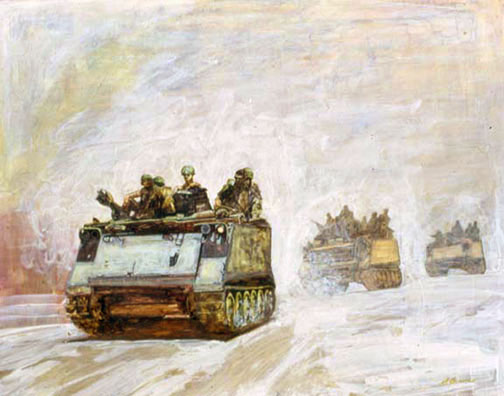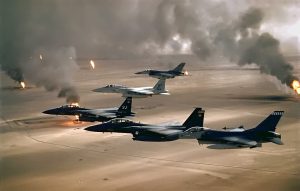
Military vehicles develop slowly, and not in very predictable ways. Most of the time, the requirements for a military vehicle are largely divorced from what manufacturers actually come up with. However, sometimes, the stars align, and magic actually happens.
Case in point: the M113.

As World War 2 developed, the United States developed the M3 Half-Track, an odd – but highly effective – hybrid, with a wheeled front axel much like a truck, in front, with a “tracked” rear drive system that used what amounted to a very large rubber tire, stretched over a huge span.
While very strange, the M3 proved highly effective at everything from delivering infantry right behind the tanks, to light artillery, anti-aircraft and logistics, doubtless why some 38,000 ended up being produced. But, the half-track wasn’t perfect, and by the beginning of the 1950’s, the Army needed a replacement.
The M113 Armored Personnel Carrier stands as one of the most widely produced and utilized armored vehicles in military history, with its operational footprint spanning over six decades and more than 80 countries worldwide. The M113 is the unlikely gold standard for “battle taxis” arounf the world.
Since its introduction by Food Machinery Corporation (later United Defense) in 1960, the M113 has become synonymous with versatility, reliability, and adaptability in military operations across diverse theaters and conflict zones. While it can technically carry 11 troops, plus its 2-man crew, most current operators use an 8- or 9-man squad.
Originally developed to meet the U.S. Army’s requirement for a lightweight, amphibious armored personnel carrier, one light enough to be air dropped, the M113 quickly demonstrated its value well beyond its initial design parameters. Two prototypes were initially produced, the aluminium-hulled T113 and the steel-hulled T114. The aluminum hull construction provided substantial weight savings compared to steel alternatives while maintaining adequate protection against small arms fire and artillery fragments. In contrast, the steel hulled design, owing to the severe weight restrictions set by the design targets, offered no greater protection than the aluminum hull. This lightweight design enabled the vehicle to achieve speeds of up to 42 mph on roads and maintain mobility across various terrains, from jungle environments to desert conditions.

The Vietnam War marked the M113’s combat debut and established its reputation for durability under harsh conditions. American forces employed thousands of M113s in Southeast Asia, where the vehicle’s amphibious capabilities proved invaluable in the Mekong Delta‘s waterlogged terrain. The “Green Dragon,” as it became known, served not only as a troop transport but also as a command post, ambulance, and fire support platform. Its aluminum armor, while initially questioned, demonstrated remarkable resistance to mines and improvised explosive devices, contributing to crew survivability rates that exceeded expectations.
International adoption of the M113 family has been unprecedented in armored vehicle history. Countries ranging from NATO allies to Middle Eastern nations, Asian powers, and African states have incorporated various M113 variants into their military arsenals. Australia, for instance, has operated M113s since the 1960’s and continues upgrading these platforms for modern operations. Similarly, nations like Norway, Denmark, and the Netherlands have maintained M113 fleets for decades, a testament to the platform’s capabilities in severe environments showing its enduring utility and cost-effectiveness.
The M113’s modular design has facilitated extensive variant development, with over 40 different “official” configurations currently documented. These include the M106 mortar carrier, M577 command post vehicle, M901 Improved TOW Vehicle, and M163 Vulcan Air Defense System; one variant, the M752, was built to launch the MGM-52 Lance tactical missile, which could launch nuclear warheads. This adaptability has allowed military forces to maximize their investment by utilizing a common chassis for multiple mission requirements, simplifying logistics, maintenance, and training procedures.

Production numbers underscore the M113’s global impact, with over 80,000 units manufactured across multiple production lines in the United States and licensed manufacturing facilities internationally. Countries including Italy, Turkey, and South Korea have produced their own variants, often incorporating indigenous modifications to meet specific operational requirements. This distributed production model has enhanced the platform’s accessibility and sustainability for allied nations.
Contemporary operations continue to validate the M113’s relevance in modern warfare. During conflicts in Iraq and Afghanistan, various nations deployed upgraded M113 variants equipped with enhanced armor packages, digital communication systems, and improved weapon stations. The platform’s relatively low signature and proven mechanical reliability have made it suitable for peacekeeping missions, border patrol duties, and domestic security operations.
The M113’s influence extends beyond traditional military applications. Law enforcement agencies, particularly SWAT teams and tactical units, have adopted surplus M113s for high-risk operations. Emergency services have converted these vehicles for disaster response, leveraging their mobility and protection in hazardous environments. This civilian adaptation demonstrates the platform’s fundamental design soundness and operational flexibility.
Modernization programs worldwide continue extending the M113’s service life well into the 21st century. Upgrade packages typically include improved armor protection, digital battlefield management systems, enhanced powertrains, and modernized weapon systems. Countries like Australia have invested hundreds of millions of dollars in comprehensive M113 upgrade programs, indicating long-term confidence in the platform’s viability.

The M113’s legacy encompasses not only its direct military impact but also its influence on subsequent armored vehicle development. Design principles established with the M113 – including aluminum construction, amphibious capability, and modular architecture – have informed modern infantry fighting vehicle development programs worldwide.
Today, despite being supplemented or replaced by newer platforms in some applications, the M113 remains actively deployed across numerous conflict zones and operational theaters. Its combination of proven reliability, operational versatility, and cost-effectiveness ensures continued relevance in military inventories globally.
The M113’s near-seven decades of service represents an exceptional achievement in military vehicle design, establishing standards for durability and adaptability that continue influencing contemporary armored vehicle development. This enduring success reflects not merely engineering excellence but also a fundamental understanding of operational requirements that transcend technological generations.
Try as it has, the US Army has not been able to completely retire the M113, although it has, yet again, announced its imminent demise. Why is this the case? After all, the M113 was designed in the 1950’s, right? well, so was the AR-15, from which we got both the M16 and the M4, neither of which have been fully replaced, either.
The answer, then, is:
If it ain’t broke, don’t fix it.









